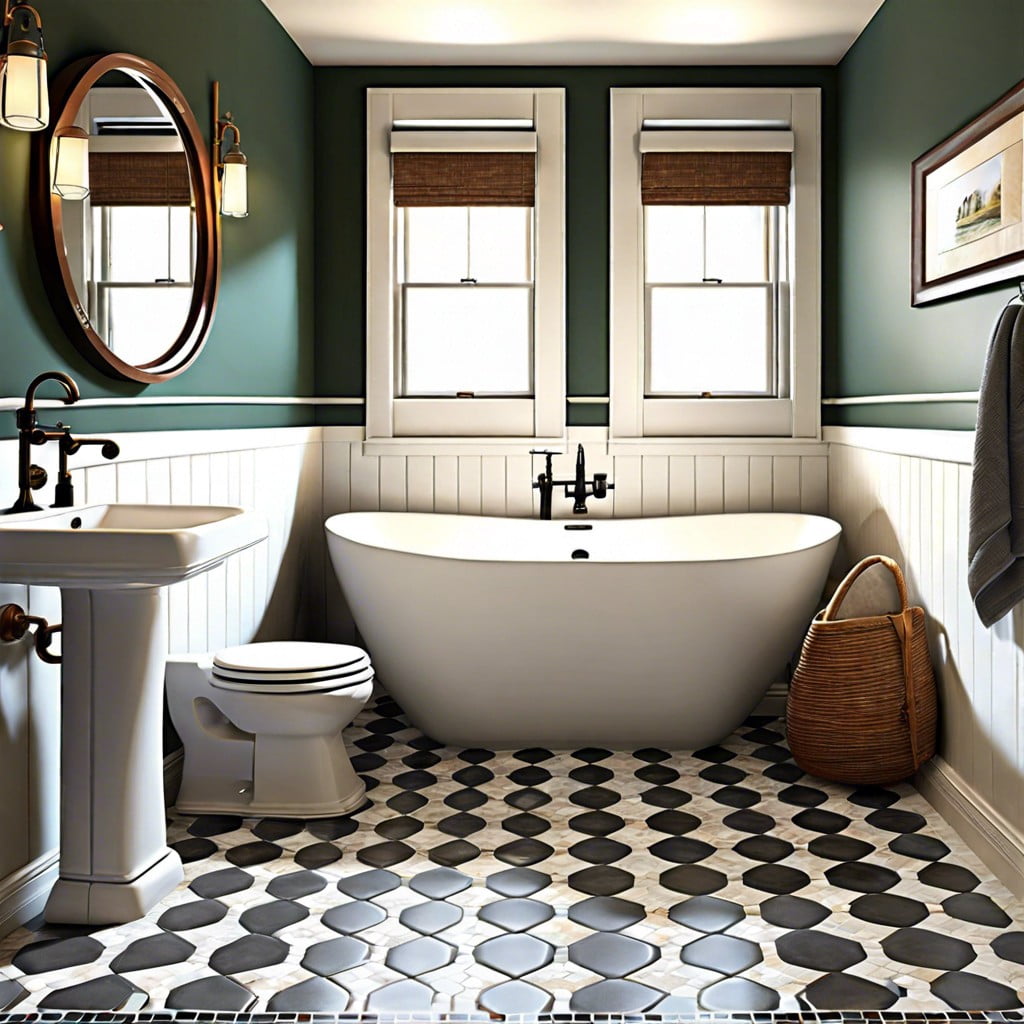Last updated on
Delve into the intriguing world of Tiffany lamps, because their rich history and exquisite craftsmanship explain their status as some of the most expensive decorative items in the world.
Diving into the world of luxurious lighting, Tiffany lamps surely top the list with their stunning designs, vibrant colors, and intricate detailing. Breathtaking works of art handcrafted for illumination, these lamps can fetch a hefty sum.
Looking for the most expensive Tiffany lamps? Brace yourself for a journey through high-end aesthetics where lamps can range from a few thousand to over a whopping two million dollars.
Every light fixture tells a captivating tale of artistry, quality, and scarcity, guaranteed to brighten any room with more than just light.
Stay connected as we shine light on the priciest Tiffany lamps in the world and what makes them worth their weight in gold.
Key takeaways:
- Tiffany lamps are some of the most expensive decorative items in the world.
- Tiffany lamps are prized for their handcrafted stained glass shades and unique designs.
- The craftsmanship behind Tiffany lamps involves meticulous cutting, soldering, and intricate metalwork.
- Iconic Tiffany lamp designs include Dragonfly, Wisteria, and Peony.
- Record-breaking Tiffany lamp sales have reached millions of dollars.
Understanding Tiffany Lamps and Their Value
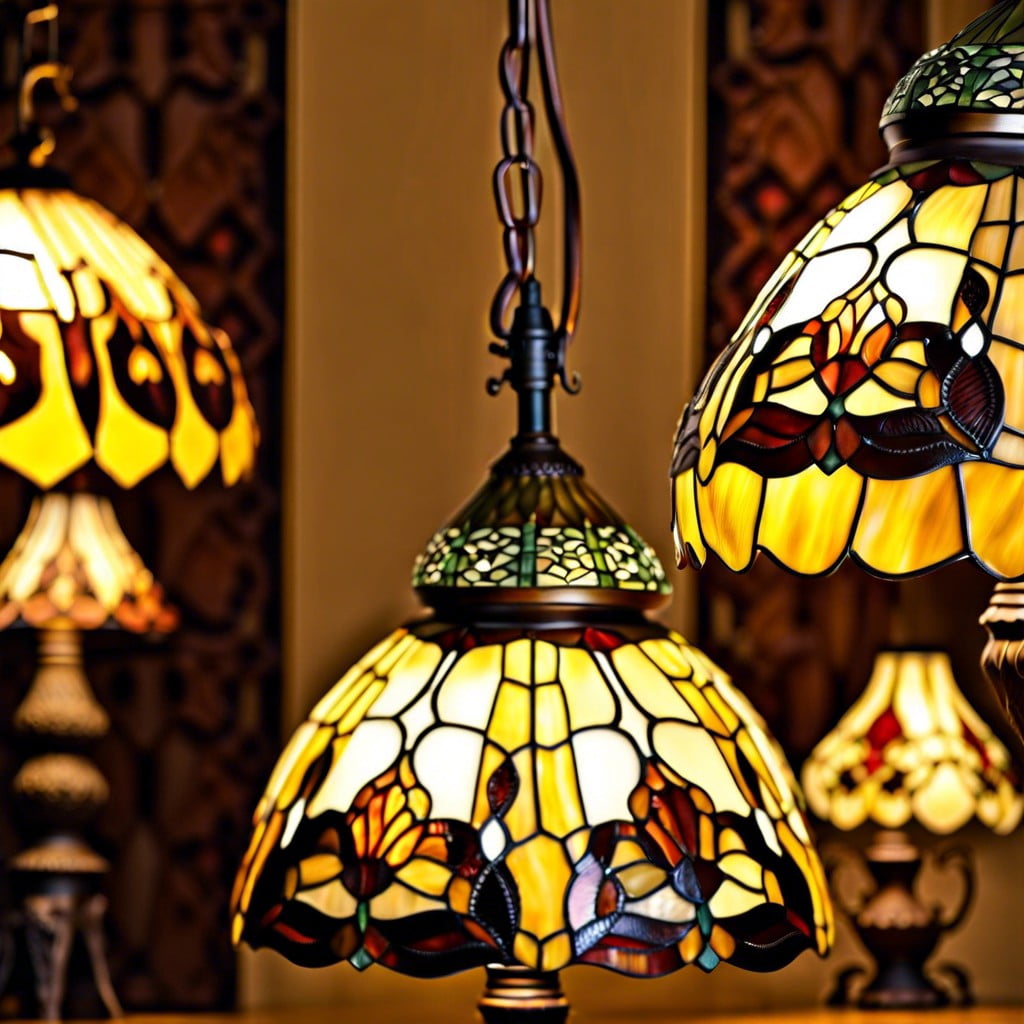
Tiffany lamps, renowned for their exquisite beauty and intricate craftsmanship, represent not only functional lighting but also treasured art pieces. Created in the late 19th and early 20th centuries by Louis Comfort Tiffany and his design studio, these lamps are prized for their handcrafted stained glass shades and unique designs. They embody the Art Nouveau movement with nature-inspired motifs and flowing, organic lines.
The lamps gained value due to their historical significance, the quality of materials used, and the time-intensive methods required for their production. Each piece of stained glass, carefully selected for its color and texture, was cut and soldered into place by skilled artisans, making every lamp one of a kind. Limited production runs and the survival rate of these lamps over a century have made them rare collector’s items that can fetch high prices at auctions and antique dealers.
Their value is enhanced by their association with the Tiffany name, a brand synonymous with luxury and high-quality craftsmanship. Recognized worldwide, authentic Tiffany lamps are coveted items that often increase in value, making them not just ornamental but also a wise investment for collectors and enthusiasts alike.
The Craftsmanship Behind Tiffany Lamps
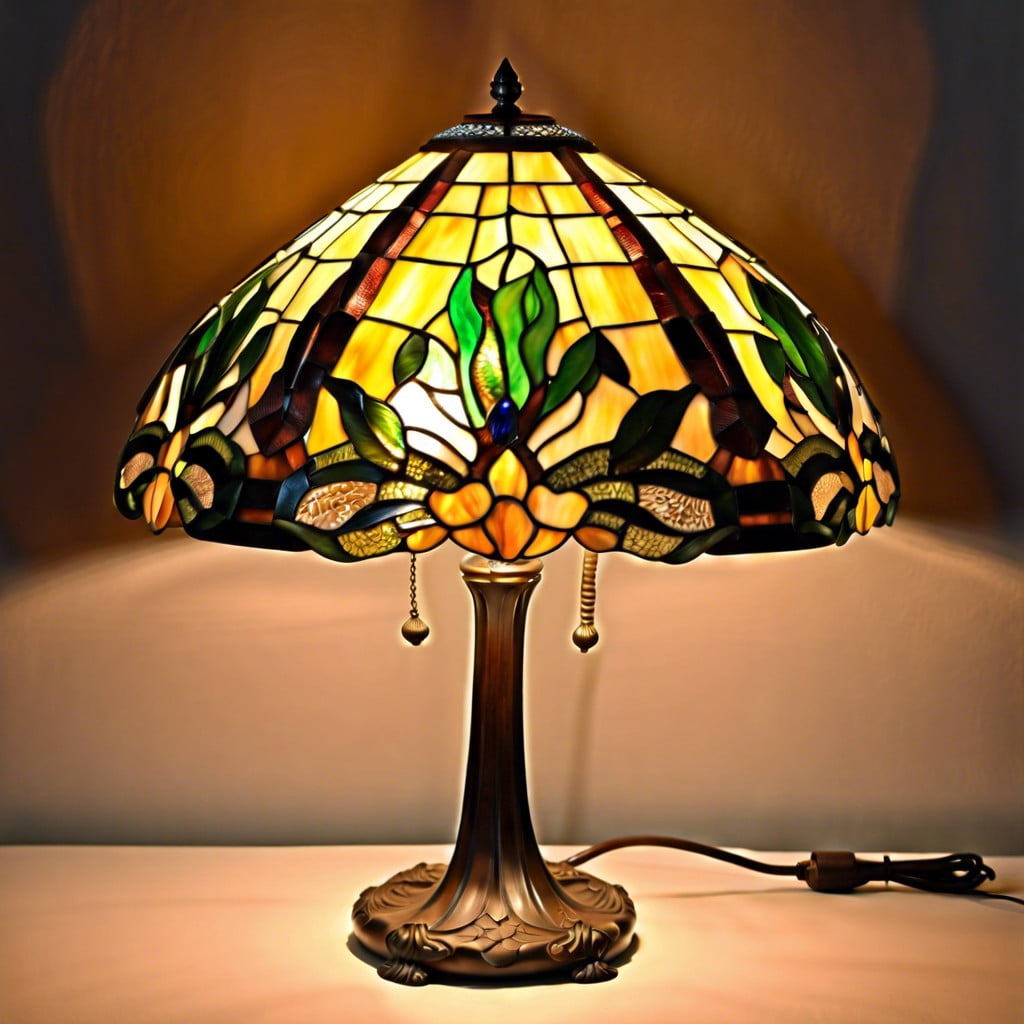
Tiffany lamps are celebrated for their exquisite hand-crafted quality. Each lampshade is created with individual pieces of stained glass, meticulously cut and edged with copper foil. This time-honored technique, known as copper foil or the Tiffany technique, was developed by Louis Comfort Tiffany and his team of artisans in the late 19th century, revolutionizing the art of glassmaking.
The glass used in these lamps is not ordinary; it’s opalescent glass made by mixing different colors while the glass is still molten. The result is a rich, multi-dimensional hue that changes intensity and color depending on the light source and angle of view.
Precise soldering is another crucial step, where each piece of glass is joined to the next with a fine bead of solder. This not only creates the lamp’s structural integrity but also contributes to the intricate outline that defines each pattern.
The lamp bases, often overlooked, are art pieces in their own right. Cast in various metals, the bases frequently feature intricate designs and patinas that complement the glass work’s natural motifs. Each base echoes an artful harmony with the lampshade, ensuring a seamless aesthetic appeal.
Iconic Tiffany Lamp Designs
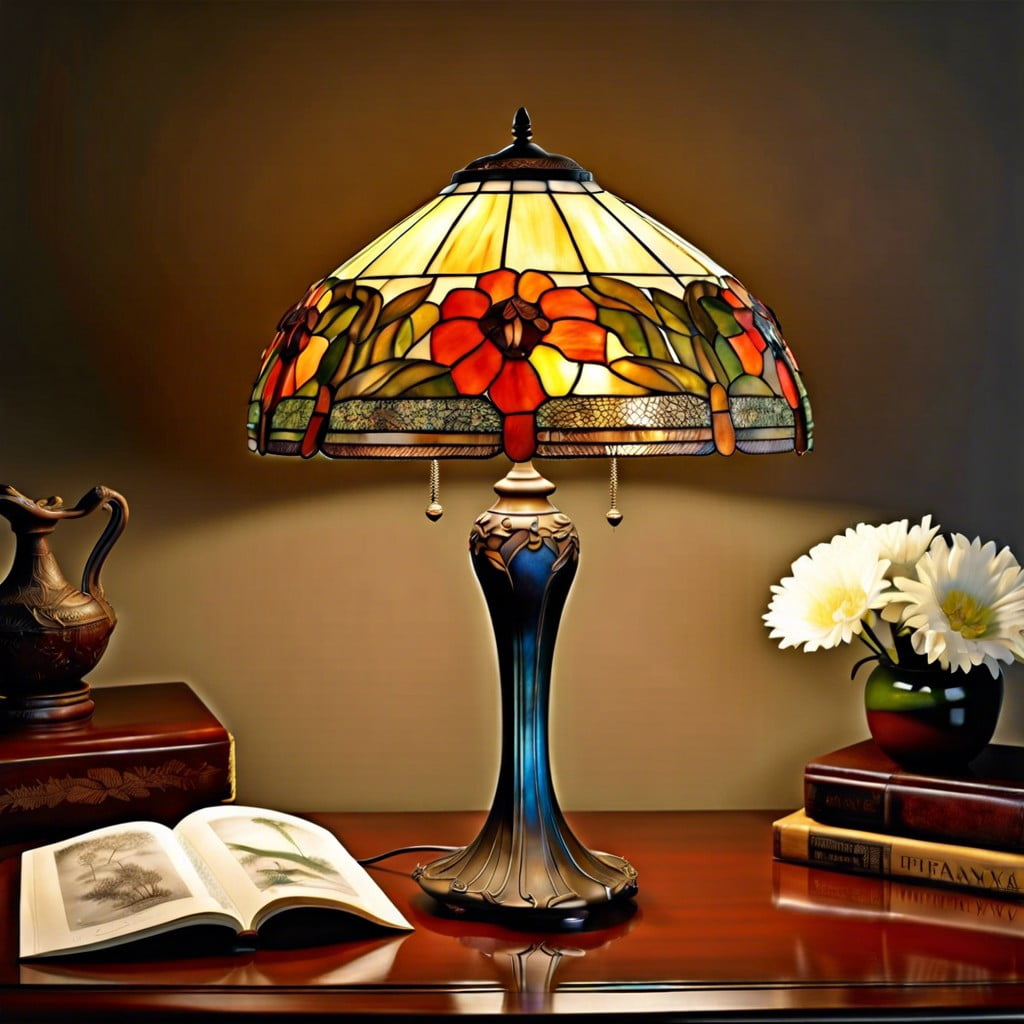
Several designs stand out in the world of Tiffany lamps, each characterized by its unique patterns, colors, and motifs inspired by nature, art, and architecture. Among the most celebrated:
- The Dragonfly lamp features intricately patterned wings with bright, eye-catching colors, often with a mosaic design on its base.
- The Wisteria design mirrors the cascading blooms of the wisteria plant, with careful attention to the hues and the draping shape of the lampshade.
- The Peony lamp showcases the full, lush bloom of the peony flower, often in rich pinks and reds, symbolizing wealth and prosperity.
- The geometric patterns, unlike the floral designs, are defined by their straight lines and angles, reflecting the Art Deco influence and appealing for their symmetrical beauty.
- The Nautilus Seashell design takes inspiration from the sea, with a lampshade that mimics the spirals and natural elegance of seashells.
Each design is not merely a source of light but an embodiment of Louis Comfort Tiffany’s innovative artistry and the effort of the skilled artisans who crafted them. These lamp designs have transcended their era to become timeless pieces highly sought after by collectors and design aficionados.
Factors Contributing to the High Cost of Tiffany Lamps
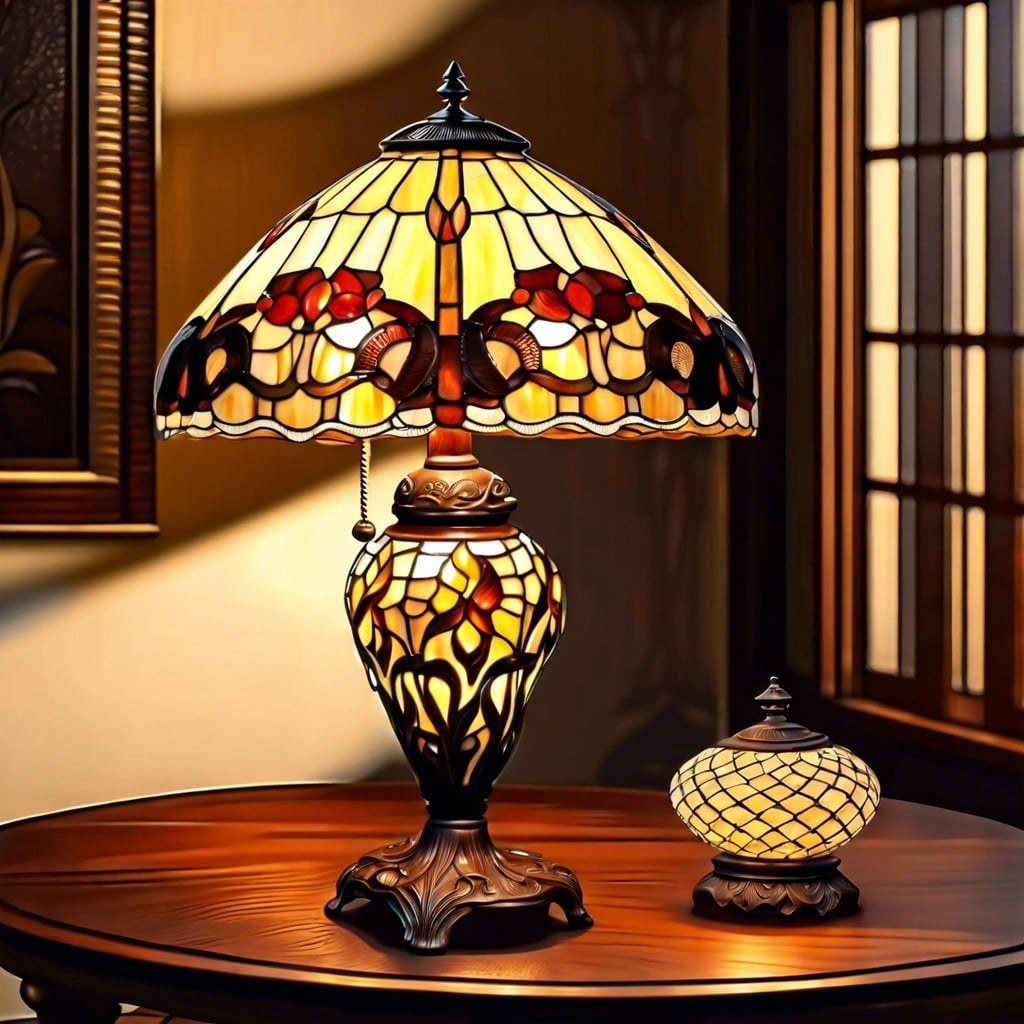
The unique artistry of Louis Comfort Tiffany’s design vision elevates these lamps far beyond ordinary decor. Each piece stems from an era where handcrafted detail was cherished, often incorporating hundreds of pieces of stained glass, each meticulously cut and soldered together.
Scarcity also plays a role in their valuation. Many Tiffany lamps are over a century old, having been manufactured in the late 1800s to early 1900s, and their numbers are limited. This, coupled with their recognized status as art, drives up demand among collectors and art enthusiasts.
Provenance can further inflate the cost—if a lamp has a documented history of ownership or has been featured in significant collections, its value may see a substantial increase. Finally, condition is crucial; lamps that have managed to survive the test of time without damage or with professional restoration can fetch higher prices in the market.
Record-Breaking Tiffany Lamp Sales
In recent years, the auction world has witnessed staggering bids for these luminous pieces of art. A Pink Lotus lamp, regarded for its rarity and intricate design, once fetched a monumental $2.8 million, setting a record for the most expensive Tiffany lamp ever sold. Its 8,000 hand-cut glass pieces reflect the level of detail and expertise that warrants such a premium.
Similarly, the Pond Lily table lamp, with its stunning 18-light design, was sold for an impressive $3.37 million. This soars above initial estimates, illustrating the competitive appetite among collectors.
Dragonfly lamps are also among the high achievers at sales, with exceptional examples reaching well into the hundreds of thousands. They are often prized for their vibrant glass colors and the intricacy of their metal filigree overlays.
These record prices underscore the significance of provenance, condition, and rarity in determining the value – a trend that continues to escalate as more collectors seek to own a piece of the historic Tiffany legacy.
Caring for Tiffany Lamps
Regular dusting with a soft cloth prevents buildup on the glass surfaces and retains the lamp’s lustrous appearance. For more thorough cleaning, use a damp cloth with a gentle, non-abrasive cleaner and dry immediately to avoid water spots.
Avoid using harsh chemicals or abrasive materials that can damage the patina of the lamp’s metal parts. If necessary, a light coating of lemon oil can keep metal finishes in good condition.
When replacing bulbs, opt for low wattage to minimize heat stress on the glass, which can lead to cracking.
It’s important to inspect the lamp’s wiring periodically, especially for antique pieces, to ensure electrical safety and functionality. Professional rewiring might be needed over time.
Keep Tiffany lamps out of direct sunlight to prevent fading of the colored glass, which can diminish the lamp’s vibrant hues.
By maintaining a stable environment free from drastic temperature changes and away from high-traffic areas, you can protect the lamp from unnecessary wear and potential damage.
Where to View or Purchase Authentic Tiffany Lamps
Discovering the dazzling intricacies of authentic Tiffany lamps is a journey into art history and exquisite craftsmanship. To indulge in their beauty firsthand:
- Visit renowned museums such as the Metropolitan Museum of Art in New York or the Charles Hosmer Morse Museum of American Art in Florida. These institutions house impressive collections for public admiration.
- Explore reputable antique dealers and galleries specializing in Art Nouveau pieces. Ensure they provide provenance and authenticity certificates for their lamps.
- Attend top-tier auctions, like those held by Christie’s or Sotheby’s, where rare and valuable Tiffany lamps often come under the gavel. Advance registration is typically required to participate as a bidder.
- Engage with established online marketplaces that offer buyer protection and authenticity guarantees, but exercise due diligence and verify seller credibility.
- For brand-new reproductions that capture the spirit of original Tiffany lamps, consider high-end lighting boutiques that collaborate with skilled artisans.
Remember that authentication is key; consult experts and use resources like the Tiffany Lamp Price Guide for added insights.
The Future Investment Potential of Tiffany Lamps
Antique luxury items like Tiffany lamps often retain or increase in value over time, making them sought-after by collectors and investors alike. Historically, the market for these lamps has been robust, driven by their rarity, historical significance, and enduring beauty.
– Rarity continues to fuel desirability: As fewer authentic pieces are available, those that come to market are met with enthusiasm, often achieving impressive prices.
– Historical significance as investment leverage: Collectors value the cultural and artistic history encapsulated in each lamp, which underpins their investment potential.
– Aesthetic longevity secures ongoing interest: The timeless designs of Tiffany lamps continue to appeal to contemporary tastes, ensuring a consistent demand.
– Market trends show resilience: Despite economic fluctuations, the art market, including Tiffany lamps, has demonstrated resilience, often outperforming traditional investments.
Investing in a Tiffany lamp is not just about owning a piece of history; it’s about making a choice that could potentially appreciate in value, adding a luminous asset to one’s investment portfolio.
FAQ
Is my Tiffany lamp worth anything?
Yes, your Tiffany lamp could potentially be worth anywhere from $5,000 to over $1 million, if it is an original piece made between 1890 and 1930.
What makes Tiffany lamps so expensive?
Tiffany lamps carry a high price tag due to their handmade construction and the use of premium quality materials.
What is the most expensive lamp on the market?
The most expensive lamp on the market is the Pink Lotus Tiffany Lamp, with a staggering price tag of $2.8 million.
What is the record price for Tiffany lamp?
The record price for a Tiffany lamp at auction is $3,745,000.
How can you accurately appraise the value of a Tiffany lamp?
To accurately appraise the value of a Tiffany lamp, you will need to consider factors like authenticity, condition, rarity, and market demand, preferably with the help of a certified antique specialist.
How does the rarity and craftsmanship contribute to the price of Tiffany lamps?
The rarity of Tiffany lamps, coupled with the meticulous craftsmanship required to create each unique piece, significantly inflates their price.
Are there any marked differences in value between various models of Tiffany lamps?
Yes, the value of different models of Tiffany lamps can vary significantly due to factors such as the design complexity, condition, provenance, and rarity of the model.
Recap


